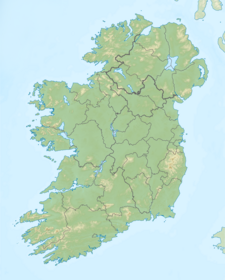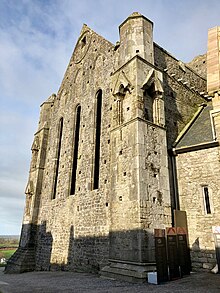Rock of Cashel
Carraig Phádraig | |
 | |
| Location | Cashel, County Tipperary, Ireland |
|---|---|
| Coordinates | 52°31′12″N 7°53′24″W / 52.52000°N 7.89000°W |
| History | |
| Founded | From 12th century |
| Site notes | |
| Website | heritageireland |
| Reference no. | 128 |
The Rock of Cashel (Irish: Carraig Phádraig [ˈcaɾˠəɟ ˈfˠaːd̪ˠɾˠəɟ]), also known as Cashel of the Kings and St. Patrick's Rock, is a historical site located at Cashel, County Tipperary, Ireland.
History

According to local legends, the Rock of Cashel originated in the Devil's Bit, a mountain 20 miles (30 km) north of Cashel when St. Patrick banished Satan from a cave, resulting in the Rock's landing in Cashel.[1] Cashel is reputed to be the site of the conversion of the King of Munster by Saint Patrick in the 5th century.
The Rock of Cashel was the traditional seat of the
Buildings on the Rock
Cormac's Chapel


Cormac's Chapel, the chapel of King
Cathedral

The cathedral, built between 1235 and 1270, is an
In 1647, during the Irish Confederate Wars, Cashel was sacked by English Parliamentarian troops under Murrough O'Brien, 1st Earl of Inchiquin. The Irish Confederate troops there were massacred, as were the Catholic clergy, including Theobald Stapleton. Inchiquin's troops looted or destroyed many important religious artefacts.[2]
Sometime during or after the mid-1730s, the main cathedral roof was destroyed by
Queen Elizabeth II visited the Rock of Cashel during her 2011 visit to Ireland.[5]
The Round Tower

The oldest and tallest of the structure is the well preserved round tower 28 metres (92 ft) high, dating from c.1100. Its entrance is 3.7 metres (12 ft) from the ground, necessitated by a shallow foundation (about 1 metre (3 feet) typical of round towers. The tower was built using the dry stone method. Modern conservationists have filled in some of the tower with mortar for safety reasons.
Other features


The entire plateau on which the buildings and graveyard lie is walled. In the grounds around the buildings an extensive graveyard includes a number of high crosses. Scully's Cross, one of the largest and most famous high crosses here, originally constructed in 1860 to commemorate the Scully family, was destroyed in 1976 when lightning struck a metal rod that ran the length of the cross. The remains of the top of the cross now lie at the base of the cross adjacent to the rock wall.
Burials
- Malcolm Hamilton (archbishop)
See also
- Eóganachta
- Hore Abbey
- Kings of Desmond
- Synod of Cashel
- National monuments of Ireland
References
- ^ a b c Seymour, John (1907). Records of the past. Vol. 6. Records of the Past Exploration Society. pp. 259–263.
- ^ a b c Howitt, William (1864). Ruined abbeys and castles of Great Britain. Vol. 2. A.W. Bennett. pp. 159–161.
- ^ "The Rock of Cashel | Heritage Ireland".
- ^ Rev. John Healy, LL.D, (Anglican Rector of Kells & Canon of St Patrick's, Dublin) History of the Diocese of Meath: Vol. II. (Association for Promoting Christian Knowledge; 1908) p. 93.
- ^ The Queen in Ireland: day four as it happened Archived 28 May 2018 at the Wayback Machine
External links
 Media related to Rock of Cashel at Wikimedia Commons
Media related to Rock of Cashel at Wikimedia Commons- Rock of Cashel on Heritage Ireland site



